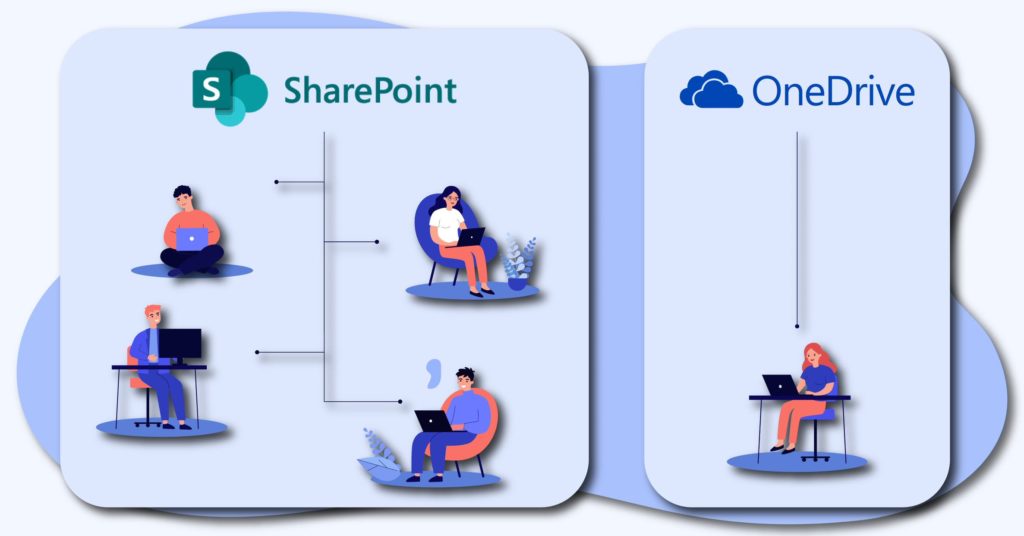SharePoint and OneDrive are both popular Microsoft services for content management, but they serve different purposes.
This article examines SharePoint vs one drive capabilities to understand when SharePoint delivers more robust tools.
Many businesses use SharePoint or OneDrive without realizing one platform may better serve their needs. We’ll compare the two side-by-side, exploring features like:
- Document management
- Collaboration
- Customization
- Security
If your business wants to organize large volumes of content with fine-tuned permissions and workflows, SharePoint offers greater power. But if you just need a place for individuals to access or share personal files, OneDrive provides simpler file sharing.
SharePoint Provides Centralized Document Management
SharePoint is built as an enterprise content management system (CMS). It provides centralized control with powerful tools for:
- Document storage and management
- Version history
- Advanced metadata
- Content workflows
Organizations can store files within a common SharePoint library. This centralized access simplifies finding the right version of a document – a key advantage over network drives.
With SharePoint, you can:
- Define document metadata like clients, partners, or projects to categorize files
- Manage file versions so you restore previous iterations
- Allow multiple authors to co-author documents
- Moderate content publishing with customizable workflows
Comparatively, OneDrive gives individual users their own document libraries with limited metadata or versioning capabilities.
SharePoint Offers Superior Libraries
SharePoint document libraries provide features tailored for corporate use:
- Metadata columns to categorize documents
- Version history to track changes
- Check-in/out control for editing documents
- Automated content workflows
- Access requests to control permissions
For example, when managing client deliverables, you can tag files by client name and project status metadata. You can also restrict access through finely tuned permissions.
Meanwhile, OneDrive libraries let you categorize documents using folders only.
SharePoint Enables True Collaboration
SharePoint provides intranet portals called sites to connect teams and projects. Sites include:
- Team site – For groups to share documents and news
- Project site – To coordinate project deliverables
- Department site – For organization-wide announcements
Within these sites, SharePoint collaboration features enable workers across departments or locations to coordinate smoothly:
- Co-author documents – Allow real-time editing by multiple authors
- Leave comments – Annotate documents during review cycles
- Customize views – Filter libraries by metadata to show relevant content
- Alerts and notifications – Stay updated on changes
- Wikis and blogs – Share status updates
With its focus on working together, SharePoint facilitatesModes collaboration at a wider team or organizational level.
Meanwhile, OneDrive enables simpler collaboration around personal storage. Users invite others to shared folders owned by individuals.
Without metadata filters or customizable team sites, OneDrive doesn’t allow the cross-company coordination SharePoint provides.
SharePoint Permissions Boost Security
With individuals and groups accessing sensitive business content, security is a concern for both platforms.
Fortunately, SharePoint provides more granular capabilities than OneDrive:
- Per-item permissions – Specify users who can access individual files
- Auditing – Track who viewed, edited, downloaded or deleted content
- Automated policy enforcement – Set governance rules based on content age, user actions, etc
- Data loss prevention – Block high-risk downloads like financial records or PII
- Multi-factor authentication – Enforce verification beyond username/password
Comparatively, OneDrive permissions are limited to handing ownership of entire folders to specific people. There are no options to audit actions or assign custom rules.
For regulated industries like financial services, SharePoint provides the event tracking and control vital for compliance.
SharePoint Enables Custom Business Processes
With SharePoint’s expansive platform capabilities, organizations can build customized environments to handle processes like:
- Content review/approval – Route documents to stakeholders for signoff
- Project management – Automate workflows to coordinate teams
- Ingest 3rd party data – Aggregate business data using PowerApps
- Business intelligence – Analyze data trends in PowerBI dashboards
- Custom applications – Extend SharePoint’s out-of-box features
Essentially, SharePoint can evolve into a hub for managing cross-departmental processes on a single platform.
Meanwhile, OneDrive has little ability to model business processes. It exclusively handles personal storage needs.

OneDrive Works Well For Individual Users
However, OneDrive has a place in business as a personal productivity platform. Consider using OneDrive when:
- You need a place for individuals to store or share documents
- Your focus is user-centric collaboration through shared folders
- You want a simple interface with no advanced configurations
- You need desktop/mobile access for remote workers
- Your users handle mostly personal files, not team assets
If these criteria describe your situation, OneDrive may suit your needs. But to coordinate large groups, formalize business processes, or manage documents at scale, SharePoint is the better choice.
Deciding Between SharePoint and OneDrive
When choosing between the two platforms, first consider your use cases:
| Key Criteria | SharePoint | OneDrive |
| Content purpose | Shared team assets | Personal storage |
| Key users | Groups and teams | Individuals |
| Collaboration style | Cross-company portals | Shared folders |
| Customization | Highly customizable | Limited options |
| Security controls | Granular controls | Folder-level only |
- If working with organizational assets, formal teams, or advanced needs – SharePoint delivers robust capabilities tailored for business.
- If focused only on personal productivity, ad hoc sharing, or ease of use – OneDrive provides a simpler, more user-friendly platform.


